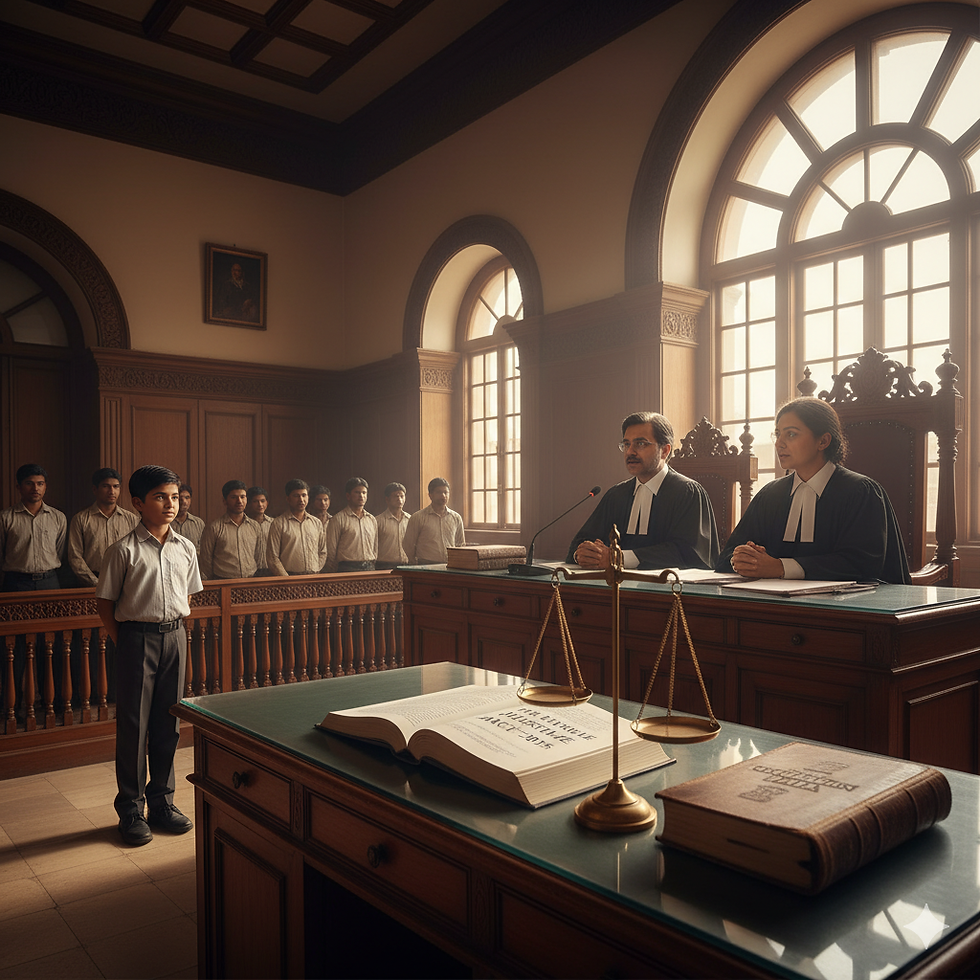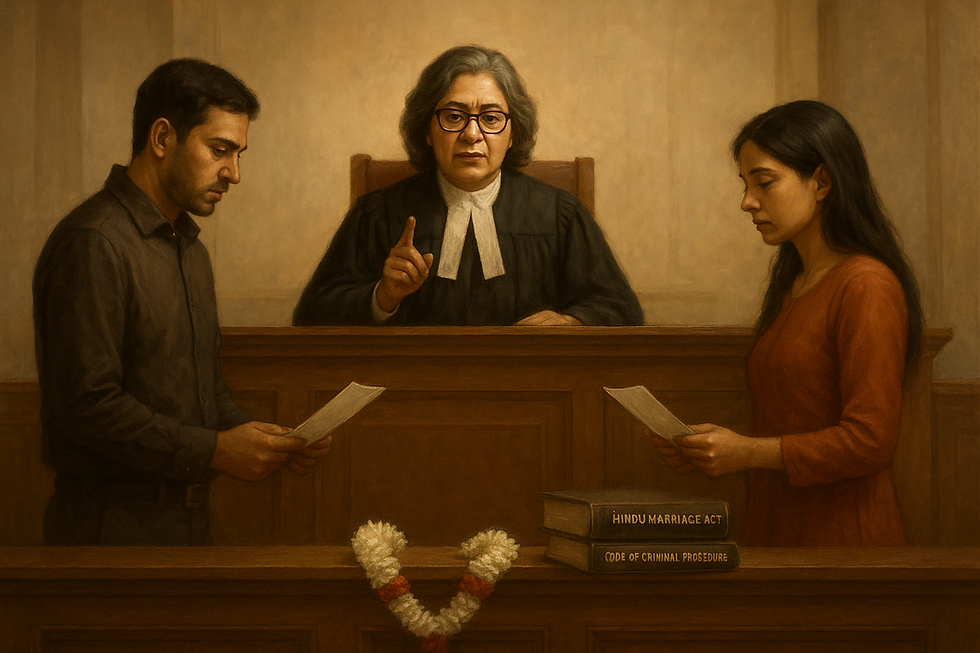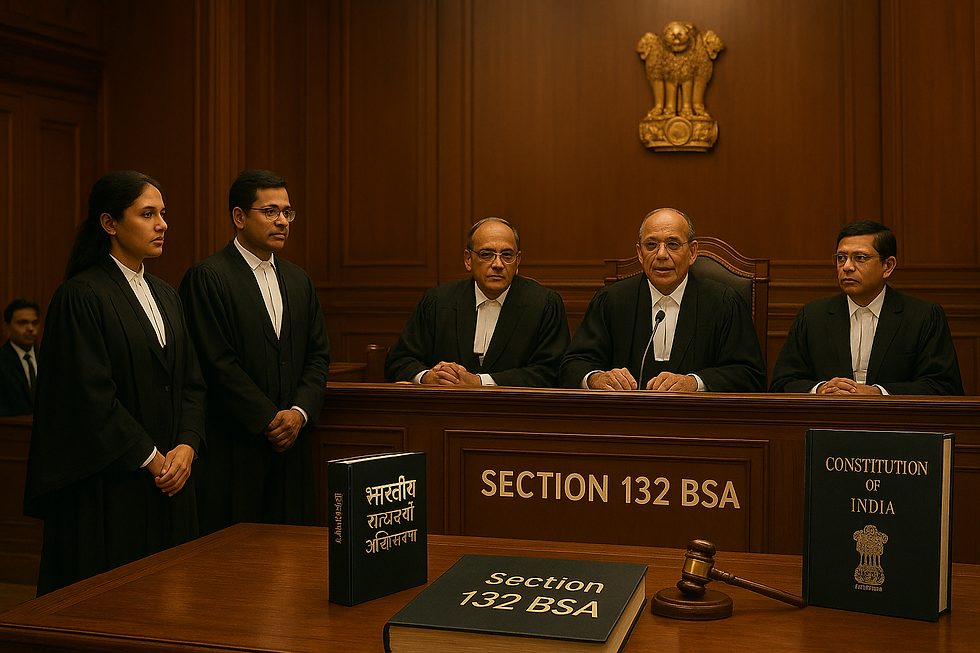Chief Justice Gavai: A Historic Tenure Begins at the Supreme Court
- Lawttorney.ai

- May 15
- 6 min read
Updated: May 22
On 14 May 2025, Chief Justice Gavai was sworn in as India's 52nd Chief Justice, a historical and constitutional moment in the judiciary of India. President Droupadi Murmu took the oath at Rashtrapati Bhavan in a ceremony that was steeped in emotion, symbolism, and dignity. With less than two months left in office (his term ends on November 23, 2025), Chief Justice Gavai is under sharp scrutiny as he takes the reins of the Supreme Court at a critical turning point in its jurisprudence.
Chief Justice Gavai's appointment is full of significance that transcends his bureaucratic functions, from his ceremonial "Jai Bhim" greeting to his profound roots in Ambedkarite thought. It is the seal of the shifting identity of India's highest court and the hope of greater inclusivity in the higher judiciary.
In the annals of Indian courts, Chief Justice Gavai occupies a unique place. He is the second Scheduled Caste individual to assume the office of Chief Justice of India after Justice K.G. Balakrishnan, and the first Buddhist Chief Justice of India. The maturation of the Indian republic and the slow, incremental progress towards an ever more representative Supreme Court are both encapsulated in this milestone nomination, which goes beyond representation.
The fact that just two Chief Justices from hitherto underrepresented communities out of more than 50 Chief Justices since the establishment of the Supreme Court indicates just how difficult it has been to create an egalitarian legal system. Thus, the emergence of Chief Justice Gavai is the time for self- and group-reflection.

An Audacious Beginning: "Jai Bhim" in the Supreme Court
Gavai's first public move as Chief Justice of India struck a chord with millions of Indians. He used the term "Jai Bhim," which has been historically associated with Dr. B.R. Ambedkar and the Dalit movement for rights, when acknowledging congratulatory messages of lawyers in the Supreme Court. That direct yet powerful declaration was more than just a formality; it was a declaration of his ideological roots and ideals of equality, justice, and dignity.
Chief Justice Gavai's introduction of Ambedkarite assertion to the revered courtrooms was a shift in culture for an institution that tends to live in a conservative, insular world.
Early Judicial Perspective and Significant Challenges
Chief Justice Gavai has a docket full of constitutional challenges at a period of high political and legal agitation. The Waqf (Amendment) Act, 2025, and the Places of Worship Act's constitutional implications are two of the most significant. All are immediately impacted by these cases in relation to the State's role in controlling religious property, minority rights, and religious freedoms.
Whether the revised Waqf law disproportionately violates the Muslim community's right to control its religious affairs—a question that arises from Article 26 of the Constitution—will be decided by the Supreme Court. Spectators await with bated breath how Chief Justice Gavai treads carefully between assertiveness and judicial restraint as these cases evolve.
The Gavai Doctrine? Hopes of Reform and Integrity
There are extremely high expectations from Chief Justice Gavai. His earlier judgments reveal a jurist devoted to balancing institutional integrity and individual liberty—a task that he now undertakes as the Supreme Court's chief.
His successor, Chief Justice Sanjiv Khanna, was also known for minimalism, particularly in not craving the media spotlight while putting pressure for internal judicial accountability. This involved hearing open probes, including the case of Justice Yashwant Varma. Whether Chief Justice Gavai will copy this low-key style of governance or become more outspoken and public is to be watched out for.
But Chief Justice Gavai has already prioritized judicial accountability. More than once, he has urged reflection within the judiciary and warned judges not to speak out in what appears too obsequious to politicians. He has demanded that the Supreme Court must remain independent and detached from executive agendas and media populism.
Controversial Remarks and Public Reactions
Not everything about Chief Justice Gavai’s career has been devoid of controversy. In one of his speeches, he remarked that “freebies” were creating a class of parasites unwilling to work—an assertion that drew significant backlash. Over 300 civil society members signed an open letter condemning the statement, calling it anti-poor and insensitive in a socio-economic context where State support is often the only lifeline for marginalized communities.
Despite this, his record as a whole presents a judge who is attuned to social justice. His friends argue that his record as a whole, cutting across constitutional, administrative, and human rights law, betrays an inclination towards reform and fairness.
The Supreme Court's Path
Chief Justice Gavai was born on 24th November, 1960, at Amravati, Maharashtra, and started practicing law in 1985. He represented local governments and universities in his long practice of constitutional and administrative law. He became a member of the Supreme Court in May, 2019 after getting promoted to the Bombay High Court in 2003 and getting permanently appointed in 2005.
His career in the judiciary was significantly guided by his father, R.S. Gavai, who was a well-known Dalit activist and former governor of Bihar. Chief Justice Gavai heard cases ranging from constitutional law to environmental justice during his judicial tenure, writing more than 300 judgments and hearing more than 700 benches.
Landmark Judgments and Constitutional Contributions
During his tenure as a judge in the Supreme Court, Chief Justice Gavai was present in some of the landmark judgments:
Abrogation of Article 370: He was part of the Bench which upheld the abrogation of the special status of Jammu and Kashmir, a milestone judgment in Indian constitutional law.
Striking Down Electoral Bonds: He was part of the Bench which held the scheme of electoral bonds to be unconstitutional on the grounds of transparency in political funding as fundamental to democracy.
Personal Liberty in the Manish Sisodia Case: His judgment enhanced the right to personal liberty, reiterating that bail should be the rule and jail the exception.
Rajiv Gandhi Assassination Case: He was the leader of the Bench that ordered the release of convict Perarivalan, reinforcing the principle of compassionate justice.
Scheduled Caste Sub-classification: He maintained the right of States to sub-categorize SCs further for targeted affirmative action—expanding the extent of reservation jurisprudence.
These rulings have established Chief Justice Gavai as a judge who understands the constitutional fabric, particularly on issues of federalism, civil rights, and affirmative action.
Legacy in Jeopardy: Challenges Before the Supreme Court
B.R. Gavai would need to take charge of sensitive legal matters as Chief Justice of India. A series of constitutional issues are raised by the current challenge to the Waqf (Amendment) Act, 2025, specifically the abolition of "Waqf by use." Following contemporary regulatory standards, how should religious customs be interpreted by the Supreme Court? How much is state intrusion permissible under Article 26?
Furthermore, when courts look at the historical legality of Waqf by use—a use where extended religious use brings religious dedication even in the absence of a formal waqfnama—Transfer of Property Act and how it harmonizes with Waqf law can perhaps be reevaluated.
Given that Chief Justice Gavai will be chairing such hearings, the legal fraternity holds its breath. His interpretation of law will leave a lasting impact on the State-minority religious institution equation for years to come.
A Short Tenure, A Long Shadow
Having held the chair for barely some six months, Chief Justice Gavai needs to act with speed and urgency. Judicial effectiveness normally takes a hit under such brief tenures, but Gavai has begun on a full throttle. He has already signaled that he will be calling for an all-judges conference to chart his vision and set judicial priorities.
Three Benches of the Supreme Court will be kept open to decide significant cases during the summer break, so it will be half functional. This guarantees that the highest court will continue to be as effective and responsive as possible when he is in charge.
Human Interaction and Lowly Origins
Chief Justice Gavai had clasped the feet of his mother at his oath-taking ceremony, a very uncommon and poignant sight that reached everyone's heart. She was even welcomed by Prime Minister Modi with respect towards each other across the judicial and political divide.
He reasserted his preference for accessibility and regional identity by taking the oath in Hindi. Coupled with his humble background and Dalit-Buddhist identity, these symbolic acts establish a powerful image of a Chief Justice of India who embodies a wider section of Indian society than many of his predecessors.
What Can We Expect from Chief Justice Gavai in the Future?
The next few months will be very important - not just for his personal legacy, but also for how people see the Supreme Court. As India faces both local and global challenges, people will be watching closely to see what values and vision he brings to the role.
Chief Justice Gavai also said that he will continue the efforts started by former Chief Justice D.Y. Chandrachud, who brought in new technology and artificial intelligence to make court work faster and easier. When asked if these changes will continue, he said, “We will continue with it.”
This is a good sign. It means the Supreme Court will keep working on using technology for online hearings and making the justice system easier to access for everyone. Empower Your Legal Practice with AI
Are you a legal professional? Stay ahead with our innovative Lawttorney.AI tool. Streamline your legal processes, enhance productivity, and gain a competitive edge. Experience the future of legal technology—try our free Webinar session today!




Comments